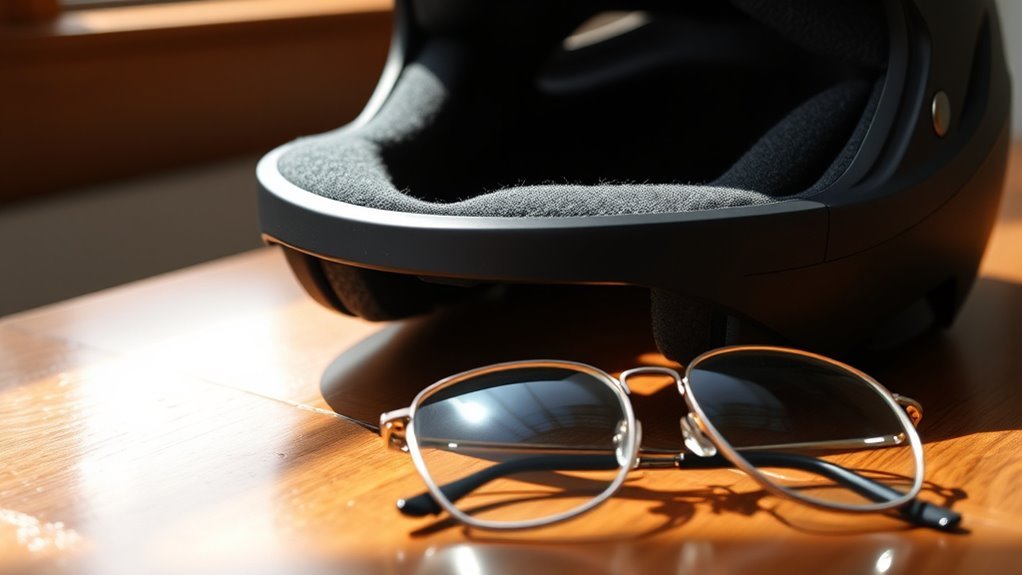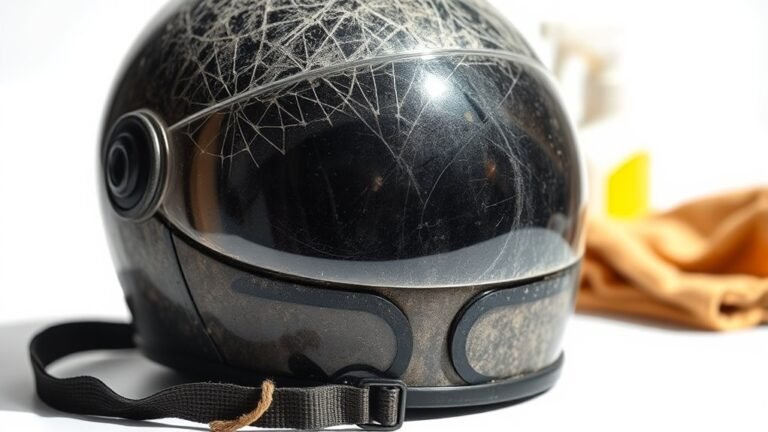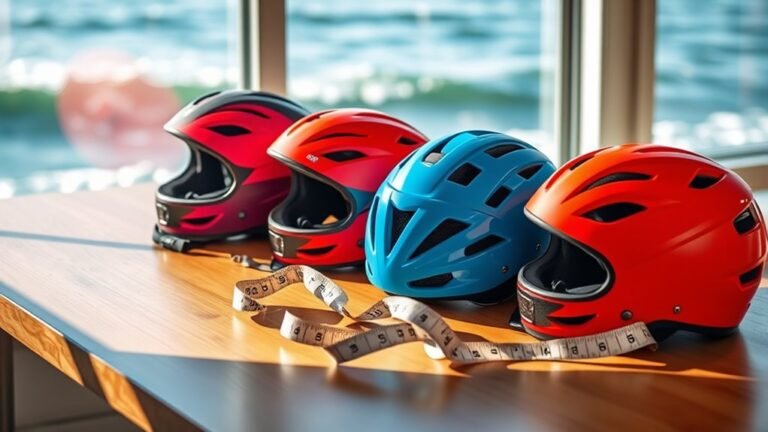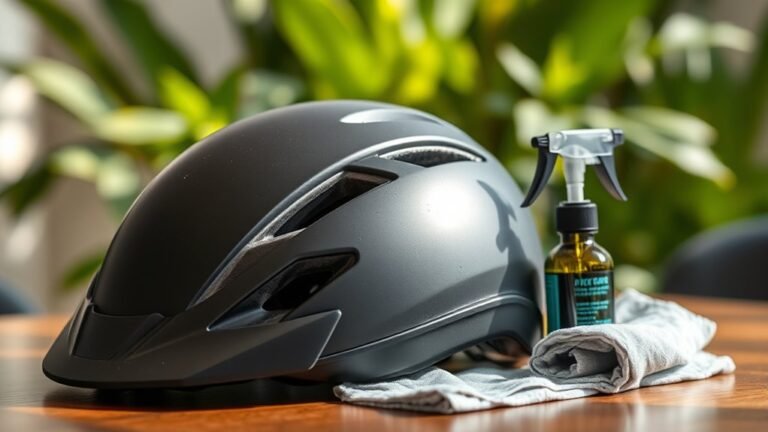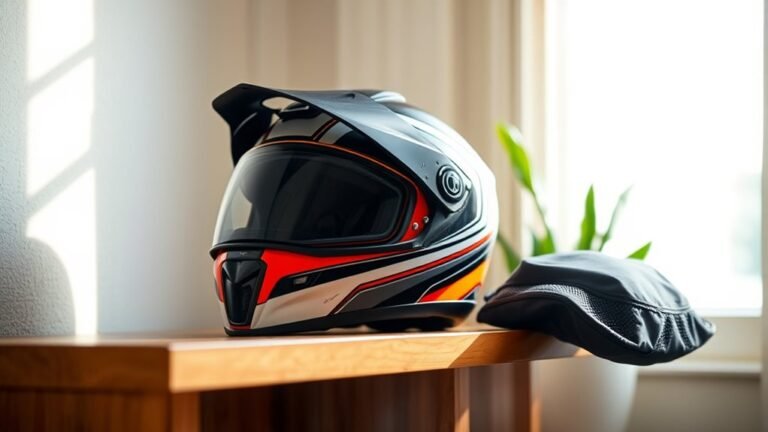Helmets for Glasses Wearers: Comfort Tips
Finding a comfortable helmet that fits well with your glasses is essential for your safety and enjoyment. Look for styles with larger eye ports and adjustable features that won’t pinch your frames. Opt for lightweight designs to reduce pressure, and choose liners that wick moisture or are removable for hygiene. Always test the fit while wearing your glasses to check for comfort. You’ll discover plenty of tips that enhance both style and practicality as you explore your options.
Understanding the Importance of Fit
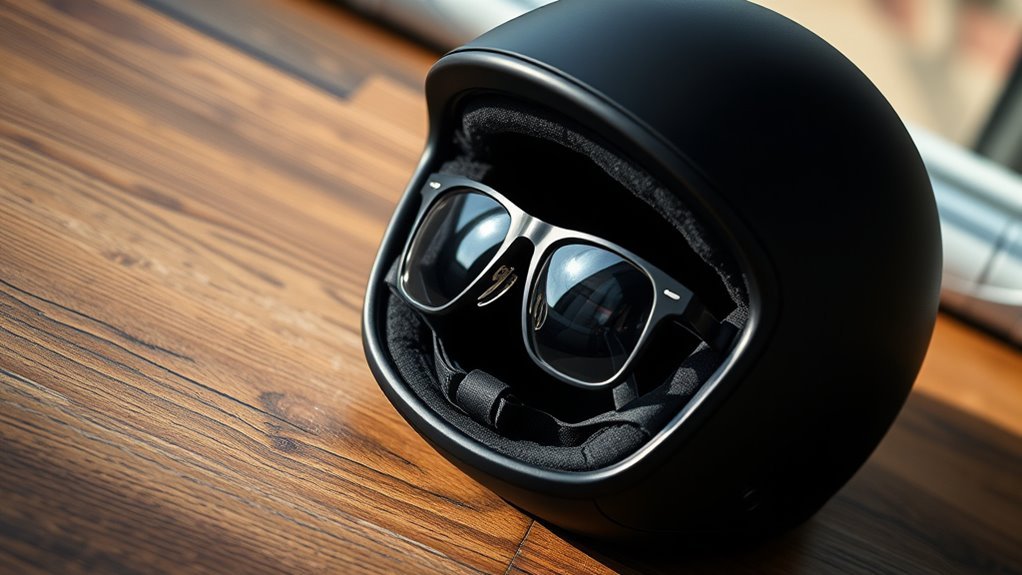
When it comes to finding the right helmet, many wearers of glasses often struggle with fit. It’s essential to take accurate fit measurements of your head to guarantee comfort and safety while wearing your glasses. A well-fitted helmet should sit snugly without pinching your frames or causing pressure points. Different helmet types can accommodate glasses better than others, so exploring options like open-face or adjustable helmets can make a big difference. Consider models with larger eye ports or specific designs that allow for more space around your temples. Remember, the right fit not only enhances your freedom to ride but also protects your vision and head. Don’t compromise on comfort—finding the perfect helmet is worth the effort!
Choosing the Right Helmet Style
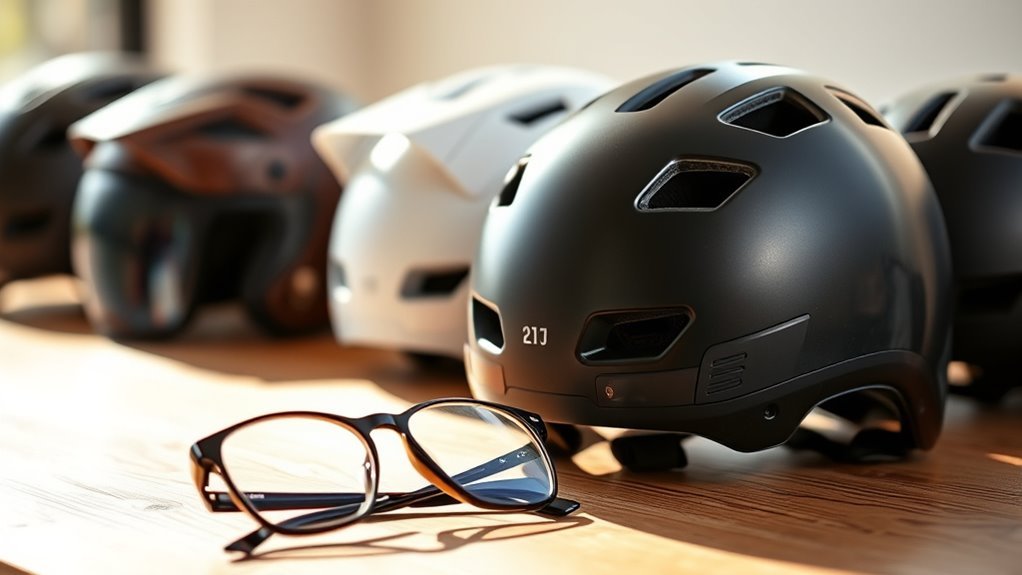
Finding the right fit is just the beginning; the style of your helmet also plays a significant role in your comfort and safety as a glasses wearer. You’ll want to explore various helmet designs to find one that complements your style preferences while accommodating your eyewear. Consider options like open-face helmets for a more liberated feel or full-face designs for maximum protection. Look for sleek, lightweight options that won’t add unnecessary bulk or pressure on your glasses. Remember, the right style not only enhances your ride but also guarantees your glasses fit comfortably without being pushed against your face. Take your time to try on different styles, and don’t hesitate to mix practicality with your personal flair for the best experience.
Look for Adjustable Features
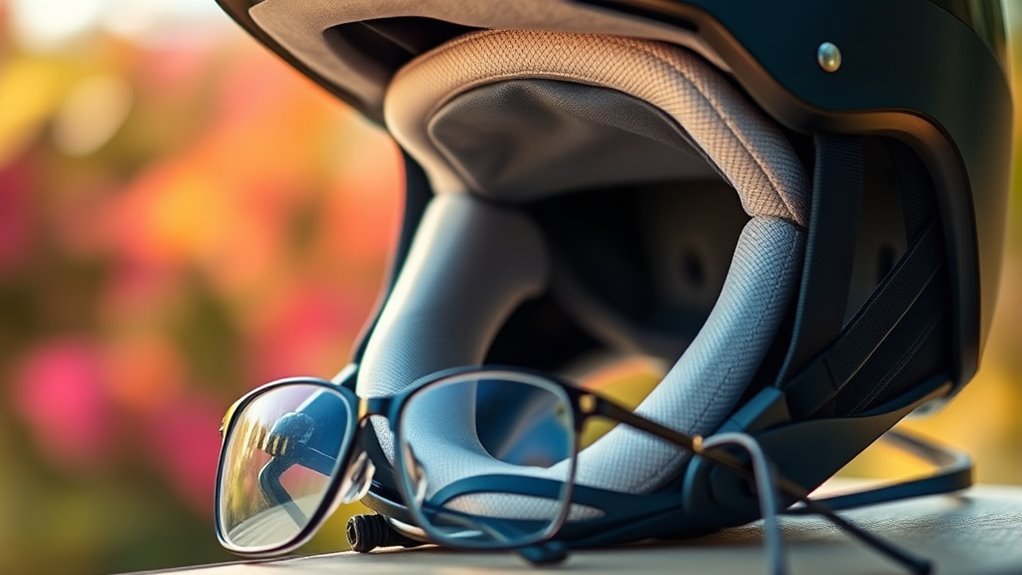
While it’s vital to choose a helmet that fits well, adjustable features can make a significant difference in your comfort as a glasses wearer. Look for helmets with adjustable chinstraps; they allow you to find that perfect fit, reducing pressure on your glasses. Customizable padding is another important feature, as it lets you modify the interior to accommodate your frames comfortably. This way, you can enjoy your ride without worrying about discomfort or potential damage to your glasses. Remember, the right adjustments can enhance your sense of freedom while riding. So, take the time to explore these features and find a helmet that not only protects but also complements your lifestyle as a glasses wearer.
Consider Liner Materials
Since comfort is essential for glasses wearers, considering the liner materials of a helmet can make a big difference in your riding experience. Different liner types can affect how well your helmet fits and feels, especially when you’re wearing glasses. Here are some options to look for:
- Foam Liners: Soft and cushioned, providing good comfort padding.
- Gel Liners: Molding to your head shape, offering a snug fit.
- Padding Materials: Moisture-wicking options help keep sweat away.
- Removable Liners: Easy to clean, ensuring hygiene and comfort.
- Ventilated Liners: Promoting airflow, reducing heat build-up.
Use Glasses-Friendly Accessories
Comfort doesn’t just stop with the helmet’s liner; using glasses-friendly accessories can greatly enhance your riding experience. You want to feel free and unencumbered, so consider investing in accessories designed with glasses compatibility in mind. Things like padded helmet straps and silicone ear pads can help minimize pressure points, making your ride more enjoyable. Additionally, look for visor options that provide ample space for your frames, preventing any annoying pinching. If you’re into night rides, consider glasses with anti-fog coatings that work well with your helmet. With these accessory options, you can ride confidently, knowing your glasses won’t hold you back. Embrace the freedom of the open road without the discomfort!
Test the Helmet With Your Glasses
Testing your helmet with your glasses is essential for ensuring a comfortable fit. You want to make sure your helmet offers both frame compatibility and lens protection. Here are some practical tips to help you test the combination:
- Wear your glasses while trying on the helmet.
- Check for pressure points on your temples or nose.
- Move your head in various directions to see if the helmet shifts.
- Assess visibility—make sure your peripheral vision isn’t obstructed.
- Ensure the helmet doesn’t pinch your frames or lenses.
Adjusting the Strap for Comfort
When adjusting your helmet’s strap, it’s important to find the right length for comfort and security. You want the helmet to sit snugly without pressing your glasses into your face, so pay attention to how it positions your eyewear. A few simple adjustments can make all the difference in your riding experience.
Proper Strap Length
Adjusting your helmet strap for the right length is essential, especially if you wear glasses. Getting this fit adjustment just right can enhance your comfort and guarantee your glasses stay in place. Here are some tips for achieving the perfect strap length:
- Check strap tension: It should be snug but not too tight.
- Adjust for your head shape: Everyone’s head is different; find what works for you.
- Make sure it sits above your ears: This helps avoid interference with your glasses.
- Test with movement: Shake your head gently to see if it stays secure.
- Reassess periodically: As you ride, your fit may change, so readjust as needed.
With these adjustments, you’ll enjoy your rides without discomfort.
Helmet Positioning Technique
Finding the right helmet positioning can make all the difference in your riding experience, especially if you wear glasses. Start by adjusting the straps to guarantee a snug fit without pinching your temples. Aim for a helmet angle that keeps it level on your head, preventing it from sliding down over your eyewear. This helps maintain eyewear compatibility, allowing your glasses to sit comfortably underneath without obstruction. Once you’ve found the right position, check that the helmet doesn’t shift when you move your head. Proper strap length is key; it should be tight enough to stay in place but loose enough for comfort. With the right adjustments, you’ll enjoy the freedom of the ride without discomfort.
Regular Maintenance for Longevity
Regular maintenance can greatly extend the life of your helmet, ensuring it continues to protect you effectively while accommodating your glasses. To keep it in top shape, follow these cleaning techniques and inspection guidelines:
- Clean the outer shell with mild soap and water to remove dirt and debris.
- Inspect the straps for wear or fraying, replacing them if necessary.
- Check the padding for cleanliness and integrity; replace any that’s damaged.
- Store your helmet in a cool, dry place to prevent material degradation.
- Examine the visor for scratches or cracks that could impair your vision.
Trying Before You Buy
When it comes to choosing a helmet that fits comfortably over your glasses, trying it on before you buy is incredibly important. Helmets come in various size variations, and finding the right fit can make all the difference in your comfort and safety. Take the time to check frame compatibility; some helmets are designed with extra space for eyeglasses, while others may squeeze your frames uncomfortably. Don’t hesitate to bring your glasses when you’re shopping—this way, you can guarantee they fit seamlessly. Adjust the straps and check for any pressure points. Remember, the right helmet can enhance your freedom and enjoyment while riding, so prioritize comfort and fit over aesthetics. Your adventures deserve the best protection!
Frequently Asked Questions
Can I Wear Contact Lenses Instead of Glasses Under a Helmet?
Yes, you can wear contact lenses under a helmet! Think of it like a bird shedding its heavy feathers to soar freely; contact lenses offer benefits like improved vision clarity and comfort. You won’t have to worry about frames getting in the way or fogging up. Many riders find that contacts enhance their experience, letting them focus on the road ahead without distractions. So, embrace that freedom and enjoy your ride!
Are There Specific Helmets Designed Exclusively for Glasses Wearers?
Yes, there are helmets designed specifically for glasses wearers. These helmets often feature style considerations that accommodate frames and include additional foam padding for comfort. When choosing one, look for models with a larger eye port or adjustable fit systems to guarantee your glasses fit snugly without pressure. You deserve to ride freely without sacrificing comfort, so take the time to find a helmet that works well with your eyewear.
How Do I Prevent My Glasses From Fogging While Wearing a Helmet?
To prevent your glasses from fogging while wearing a helmet, consider using anti-fog solutions or sprays designed for eyewear. You’ll also benefit from helmets with built-in ventilation systems, which promote airflow and reduce moisture buildup. I know it can be frustrating, but finding the right combo can give you the freedom to ride without hassle. Don’t let foggy lenses ruin your adventure—experiment with different options until you find what works best for you!
Will Wearing a Helmet Damage My Glasses Over Time?
Wearing a helmet won’t necessarily damage your glasses over time, but it can affect lens protection. If your helmet’s materials are rough or tight, they might scratch your lenses. To prevent this, make sure your helmet fits comfortably and doesn’t press against your frames. Consider using lens protectors or opting for more durable lenses when you’re out enjoying your freedom. Taking these steps can help keep your glasses in great shape while you ride.
Is There a Weight Difference Between Glasses-Compatible and Regular Helmets?
Imagine two birds in a sky, one carrying a heavy stone while the other soars freely. When it comes to helmets, there’s often a weight difference; glasses-compatible helmets may weigh slightly more due to extra padding and materials designed for comfort. However, the difference is usually minimal and worth the trade-off for safety. Always consider the helmet materials, as lighter options can provide the freedom you seek without compromising protection.
